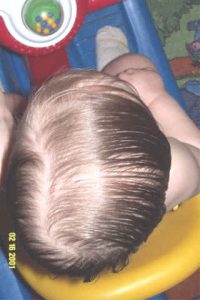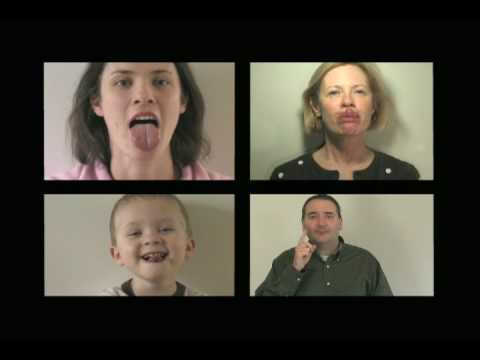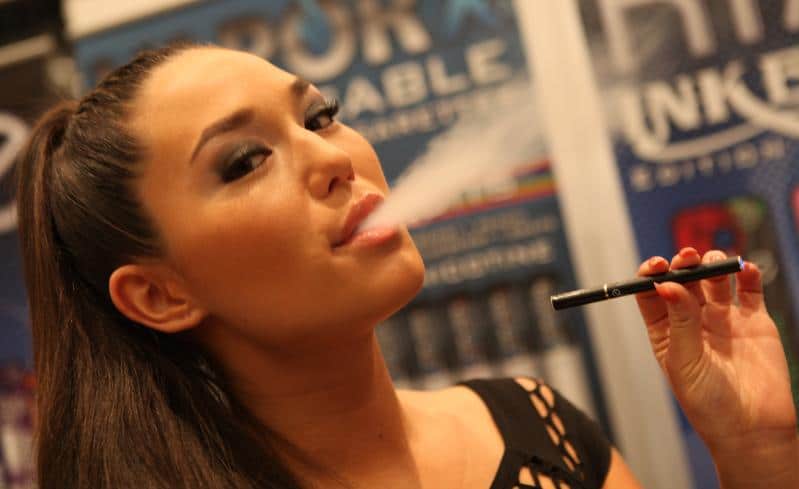Many parents often worry when they discover a flat spot on their infant’s head. Usually, a small flat spot can be corrected by repositioning your baby, but there are occasions when a flat spot can develop into something more severe – Plagiocephaly.
Every year, approximately one in 60 infants in the U.S. develops Plagiocephaly, a syndrome defined by the flattening of a baby’s head that usually occurs from consistent pressure to one area of the skull. It’s become more frequent in recent years due to the popularity of the Back to Sleep campaign, which advocates placing infants to sleep on their backs to help reduce the risk of sudden infant death syndrome (SIDS). If you are a parent whose little girl has just been diagnosed, review the information below to help you better understand the issues and treatment associated with Plagiocephaly.
Causes of Plagiocephaly
• Sleep positioning. Babies are born with soft skulls, and when they are placed on their backs to sleep every night, their little head can develop a flat spot from pressing against the mattress. Often, this occurs with infants who are born with torticollis, when a tight muscle on one side of the neck causes a child’s head to tilt slightly to one side. Notably, premature babies are the most risk of developing torticollis and plagiocephaly.
• 
• Constricted womb or multiple births. Plagiocephaly can also occur if there is insufficient room in the uterus while the baby is developing. This can happen if there are multiple births, if there’s not a sufficient amount of amniotic fluid, or if the uterus or pelvis is particularly small.
What Can Parents Do?
Talk with your pediatrician. If you find a flat spot on your baby’s head, it’s a good idea to talk with your doctor. Usually, most flat spots will eventually round out by themselves, but it’s best to check with the experts. If her case is more severe, then your doctor will recommend further treatment.
Sleep repositioning. Many times if the flat spot is minor, your doctor may recommend repositioning your baby when she sleeps to help alleviate pressure on the flat side of her head. Your pediatrician will also want you to increase tummy time for your daughter to help strengthen her neck muscles. Finally, limiting the amount of time your baby spends in bouncy seat, swings, car seat, and strollers can greatly reduce the appearance of a flat head.
Seek early diagnosis and treatment. If your child’s case is severe, she will be recommended for cranial orthotic therapy. And though the name sounds intimidating, the process is not harmful to your child. Infants are fitted for a specially customized headband that must be worn for 23 to 24 hours a day to correct the shape of her skull. Bands are usually worn from two to six months, depending on the severity of the problem. Research has found that cranial orthotic therapy is most successful when started before the age of 6 months.
If you decide to go with cranial orthotic therapy, be sure to research the various companies that offer this service to find the best fit for your child. Therapy is very expensive (on average $3,000), so you should also check with your insurance company to see exactly what they cover. Though it seems like wearing a band for 24 hours a day would be painful for an infant, most babies adjust quickly to the process.
Plagiocephaly FAQ
Q: What is the difference between Positional Plagiocephaly and Craniosynostosis?
A: Plagiocephaly is strictly the flattening of the skull due to some sort of external pressure. It can be caused prenatally by cramped quarters, or postnatally through back sleeping, or encouraged by a case of torticollis (tight neck muscle). Plagiocephaly can be treated with helmet therapy, usually alongside a physiotherapy regimen.
Craniosynostosis is the premature fusion of one or more cranial sutures. This condition will cause the head to take an abnormal shape as it grows. Craniosynostosis can only be helped with surgery. A CT scan may be required to diagnose this condition properly. [See Differential Diagnosis.]
Q: How do I know my baby has plagiocephaly?
A: Plagiocephaly can range from mild to moderate to severe. The average head shape that will likely require treatment will show the following symptoms. Please note that although many doctors can tell the difference between plagio and cranio by sight. CT scan or x-rays may be required. NOT ALL DOCTORS WILL DO THESE TESTS if a baby shows all of the “classic” symptoms.
- moderate to severe flatness at the back/back-side of the head.
- Scaphocephalic head shape (long and narrow)
- Brachycephalic head shape (entire back of the head is flat)
- The forehead on the affected side may be more prominent than that of the unaffected side.
- The ear on the affected side may be pushed more forward than the ear on the unaffected side.
- One eye may appear larger than the other.
- The nose may appear pushed to one side.
- One cheek may look fuller than the other.
- the baby may tilt the head to one side and lack range of motion (due to torticollis – tightness of a neck muscle)
Q: Does the odd shape of my baby’s head hurt her? Is it affecting her development?
A: It is unlikely that the shape of your baby’s head is hurting her. This is a common question, and as many times as it has been asked, there has been a dozen responses testifying that these babies are generally very happy. Happy babies aren’t hurting babies!
As far as plagio. Affecting development, well, yes, and no. The deformation itself is not hampering brain growth, nor is it causing any sort of mental disabilities (as far as studies can claim to date), however, the torticollis that is commonly coexistent with the plagio. May be slowing development. It is important to find a good children’s physical therapist. It may take several months to correct torticollis, and rarely a simple surgical procedure is necessary to loosen the tight muscle. Please read more about torticollis by clicking the link to the left.
Please keep in mind that one short study came to the conclusion that children that were left untreated showed lower grades in school. It was inconclusive as to whether or not it was the plagio. Itself that was the main factor in this or the self-esteem of the child due to his/her deformity.
Q: Do I need to seek treatment, or will my baby’s head round out on its own?
This is a difficult question to answer. Many factors are involved here.
What is the age of the child? If your baby is under 3 months of age, aggressive positioning techniques may help round out baby’s head. After this point, you should talk to a doctor about a timeline in which intervention may be necessary. Remember, the earlier you start treatment, the faster you will see results. Treatment should be started before one year of age and can be started up to 24 months of age (*depending on the type of helmet used – check with your doctor
What is the severity of the deformity? Very mild cases are likely going to either heal on their own (if no torticollis is involved, and positioning methods are used) or will “hide” once the child has grown a full head of hair.
If the case is moderate to severe, treatment is likely needed.
Ultimately, it is a decision the family must make together with the guidance of a doctor that is well versed on the topic of plagiocephaly. The well being of the child, both present and future is obviously the goal here.
Q: My doctor says that this condition is strictly cosmetic and that treating it would be like giving my baby a nose job!!
This is not true. A cosmetic treatment would alter a normal-looking appearance. Therapy with a cranial molding helmet/band is considered to be reconstructive, thereby normalizing the appearance of the anomalous head shape.
Q: What will happen if we don’t treat this condition?
Studies are still few and far between on this topic. It is still somewhat unclear as to what may happen, as this is still a relatively “new” condition.
Many doctors state that if left untreated, the child would develop normally, but there is evidence suggesting that vision and jaw alignment problems may occur in moderate to severe cases (keeping in mind that plagio. is not just a flattened head, but the shifting of all cranial bones).
Please also consider the self-esteem of the child in future years. I have read statements from adults who suffered as teens because of their deformed head shapes.
Q: Which doctor should I have my pediatrician refer me to?
There are a handful of doctors that will diagnose and prescribe treatment.
- neurosurgeons
- neurologists
- craniofacial plastic surgeons
When seeking out a specialist, try to find one that focuses on infants.
Q: If we decide to go with helmet therapy, how long will it take to round my baby’s head?
It depends. If you go with the “DOC Band,” Cranial Technologies gives an average treatment time frame of 4.5 months. There are also several different individually made helmets and bands out there. Each of these devices is made by private manufacturers, so to get an accurate time frame, you should talk to the orthopedist who makes that particular device.
Age and Severity are also major factors in the amount of time it will take. The younger the child, the faster you will see results. Same goes with severity – the flatter the head, more asymmetric the features, etc., the longer the treatment time.
Q: My baby is already a year old. Is it too late?
Treatment is all dependant upon the growth of the child. Babies grow the fastest in the first 7.5 months of their lives. After this point, growth slows some and then slows even more after their first birthday. This is why treatment is the most effective in the first year. Some helmet manufacturers will start treatment after the first birthday, while some stand firm that it is too late. Cranial Tech. Will “band” a child up to 24 months of age in most cases. Check with your local helmet program.
Q: How much does treatment cost? Will my insurance pay?
The cost all depends on where your baby will receive treatment. Even “Name Brand” bands/helmets vary in price from location to location. I have heard of helmet prices as low as $500.00, ranging all the way up to $3500.00 (average DOC Band price seems to range in the $3000 area). But don’t get your hopes up for that $500.00 figure!
Insurance companies can be very stubborn. Call and ask your provider if this is something they cover. If they give you a flat-out “no,” ask them to check under “durable medical equipment.” If they still say no, prepare yourself for a fight. It may take some time, and you might consider starting treatment before approval if you have an older child. On your part, it may take several appeals, and hours of research, but these fights have been won over and over in the past. Please check our insurance link.
Q: What is better, the DOC Band, the STARband, or the helmet?
There is no fair answer to this question. The DOC Band, STARband and several helmet styles have been proven to work. The best thing for you to do to answer this question is to talk to your closest Cranial Technologies clinic, contact Orthomerica, and talk to your local helmet provider. Ask about casting procedures, how that specific helmet works, estimated time that your child will have to wear the helmet, how often they make adjustments to accommodate the growing head, how many babies they have treated in the past, etc. Some parents have found that the local helmet maker recommends using the DOC Band because his/her experience is inferior to that of Cranial Tech.’s.
Q: My child’s head and band/helmet stink! How do I get rid of the smell?
Perspiration is normal and can be excessive in the first couple of weeks. Be sure to maintain a daily cleaning schedule. Ask your orthotist for any cleaning suggestions. Here are some general guidelines:
Remove the band/helmet for the recommended time. Wash the child’s head using a fragrant shampoo (L’Oreal for Kids, Head & Shoulders). Scrub the inside of the band/helmet with the recommended cleaning agent. (DOC band users note: Use only isopropyl alcohol on the inside of the band. Other products can leave a residue and cause skin damage to your child’s head). Place the band/helmet in direct sunlight for the remainder of the time of period. This will help to reduce smell and to “sun bleach” any yellowing.
Q: People are staring when we go in public. How do you handle this?
People are curious about what they do not know about. Keep a smile on your face and talk to your child. Decorate the band/helmet to make it look less medical. Use paint, stickers, rub-on transfers, Velcro bows, etc. to make it look more kid-friendly. Think of your time in public as an opportunity to educate others about plagio. Consider creating a flyer to hand to people. See the Let’s Decorate link.
Q: What is “repositioning”? How do I do it? Will it help?
Repositioning is your effort to keep the child’s head off of the flat spot. Any external forces (floor, car seat, swing, crib mattress)should be applied to the area that “sticks out.” Aggressive repositioning in young infants can help reshape the head.
When lying down or sitting, use a rolled towel under the shoulder of the affected side so that the head will naturally fall to the opposite side. When sleeping, use the rolled towel under the bedsheet. Also, mini “Boppy pillows” or other neck rings can also be helpful to change the baby’s position. *Always be careful of the items you put in your child’s crib, so they do not cause a suffocation risk.*
Repositioning may help to reshape the heads of very young babies. If your doctor suggests repositioning, ask him/her for a “timeline” at which point other intervention may be necessary. Remember that repositioning does not always work, and the earlier treatment is started, the sooner you will see results. I would recommend taking photos of your baby’s head (both sides, front, and top views) the day you start repositioning. This will help you make a fair assessment as to whether or not positioning methods are helping. Compare photos in 4-6 weeks time. See the Repositioning Techniques link. [Also see www.Repositioning.info & www.TummyTime.info]
Q: What is torticollis? Do all babies with plagiocephaly have torticollis?
Torticollis is a condition where the neck muscles on one side of the child are tighter and therefore do not allow a normal range of motion. Many, but not all children with plagio have a tort. If your child shows a preference in which way she turns her head, this may lead to the flattening of the skull behind that side. Seek help from a physical therapist to stretch the neck muscles to gain full range of motion. Check the Torticollis link.
Sources:
- Farkas, LG, and Munro, IR (1987) Anthropometric Facial Proportions in Medicine. Charles C Thomas: Springfield, 344 pp.
- Kelly KM, Littlefield TR, Pomatto JK, Ripley CE, Beals SP, Joganic EF (1999) Importance of early recognition and treatment of deformational plagiocephaly with orthotic cranioplasty. American Cleft Palate-Craniofacial Journal, 36: 127-30.
- Kolar, JC, and Salter, EM (1997) Craniofacial Anthropometry. Practical measurement of the head and face for clinical, surgical and research use. Charles C Thomas: Springfield, 334 pp.


